In this guide, we have the overall goal of providing our readers with a strong understanding of cannabinoids and—more specifically—phytocannabinoids. We will be providing you with the core generalized information on some of the most important phytocannabinoids that are currently known by the scientific and medical communities, and we will attempt to explain why cannabinoids are so important for attaining and maintaining good health. However, before jumping straight into our guide on cannabinoids, we need to quickly cover what is known as the Endocannabinoid System (ECS), as it plays a very important part in how cannabinoids affect the user in various ways.
Table of Contents
- The Endocannabinoid System
- What are Cannabinoids?
- What are Phytocannabinoids?
- Importance of Phytocannabinoid-Rich and Phytocannabinoid-Diverse Products
- Quick Reference Glossary
- Resources
The Endocannabinoid System
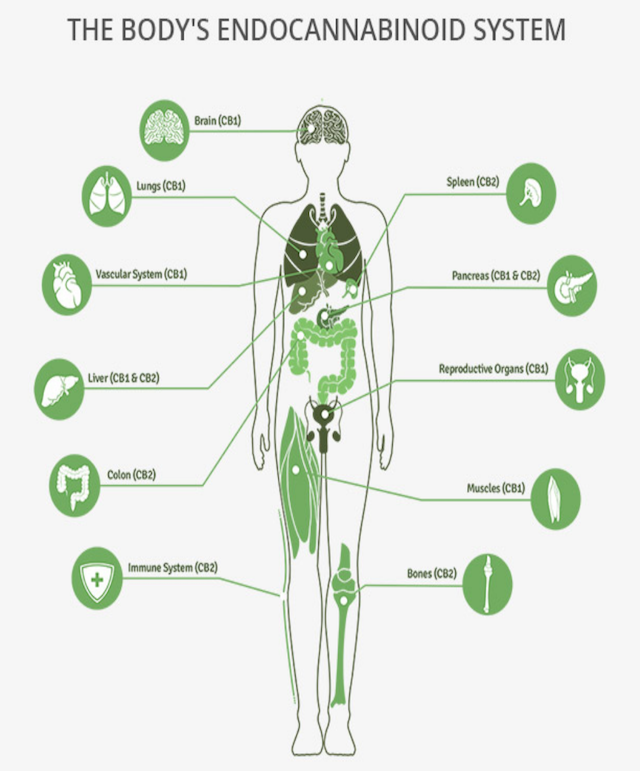
The Endocannabinoid System is the biological system that is found in most living organisms, and which is comprised of what is known as endocannabinoids. Explaining what endocannabinoids are is a very technical process, but we will provide a summary in Layman’s Terms after providing a more technical explanation.
Endocannabinoids are classified as being endogenous and lipid-based retrograde neurotransmitters that bind to cannabinoid receptors and cannabinoid receptor proteins which are expressed throughout the central nervous system found in vertebrates (including in their brains), and which are expressed throughout the peripheral nervous system.
Ligands (a Ligand in biochemistry and pharmacology, is a substance that forms a complex compound with a biomolecule in order to serve one or more of a variety of different biological purposes) for these cannabinoid receptor proteins include the endocannabinoids (these are the cannabinoids that are produced naturally in the body by animals), the phytocannabinoids (which are found in cannabis and hemp), and even synthetic cannabinoids, which are manufactured artificially in a variety of different processes.
Basically, the Endocannabinoid System uses biomolecules that are naturally occurring in an organism, tissue or cell system (this is what endogenous means) and which is soluble in non-polar solvents (these are known as lipids) to bind cannabinoid receptors and cannabinoid receptor proteins in order for the body to be able to utilize endocannabinoids and phytocannabinoids, and which can utilize scientifically- and medically-designed and manufactured synthetic cannabinoids.
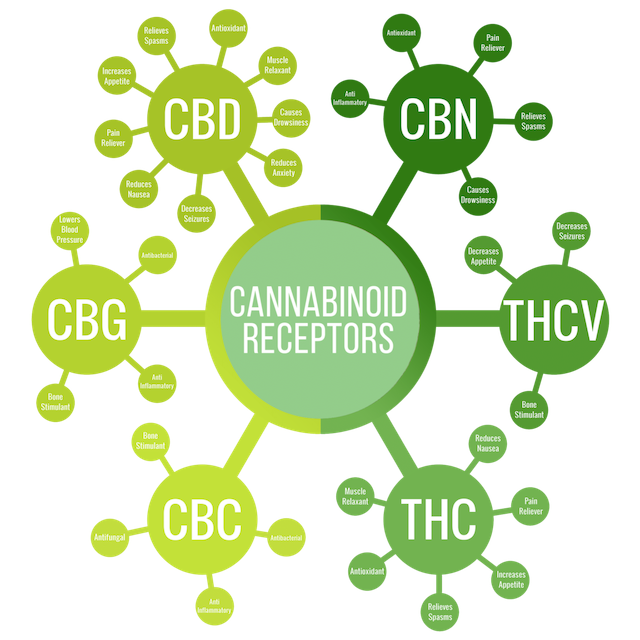
Cannabinoid binding sites are located all throughout the central and peripheral nervous systems. Cannabinoid receptors comprise a large part in the function of the Endocannabinoid System and are involved in a variety of different physiological processes, including your appetite (both the frequency of feeling hungry and the suppression of urges to snack), pain-sensation and sensation hypersensitivity, your overall mood, your memory, and various other cognitive-oriented processes, among many other processes that keep your mind and body working and healthy, and that keep your emotions in check.
Currently, the two most relevant receptors for cannabinoids are known as the Cannabinoid Receptor Type 1 (CB₁) and the Cannabinoid Receptor Type 2 (CB2) receptors, which are predominantly expressed in the brain and immune system, respectively. Additionally, it is known that there are some orphan receptors that bind cannabinoids in the nervous system. Orphan receptors are just proteins that have a similar structure to other receptors that have been previously identified, but whose endogenous ligand has not yet been identified and classified by scientists and doctors.
In the absolute simplest of terms, the Endocannabinoid System is the biological system that is found in living organisms and that allows them to utilize both natural and synthetic endocannabinoids and to break down and use phytocannabinoids. This means that the Endocannabinoid System is extremely important when it comes to the efficacy of a wide variety of different chemical compounds and plays a big role in living a healthier and happier life. Some of the most important cannabinoids that your Endocannabinoid System takes advantage of are the phytocannabinoids that are found in industrial hemp and cannabis plants. Not all cannabinoids are phytocannabinoids, but all phytocannabinoids are cannabinoids and it is important to learn the distinction between the two, so we will be tackling that together next.
What are Cannabinoids?
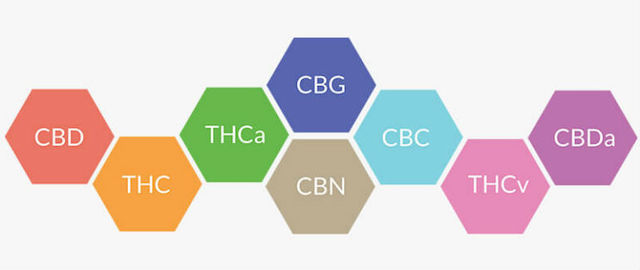
Cannabinoids are a class of chemical compounds that have an effect on the Endocannabinoid System. This family of chemical compounds alters neurotransmitter release in the brain and nervous system. Cannabinoids include both naturally-occurring and synthetic endocannabinoids and phytocannabinoids. Naturally occurring cannabinoids that are not phytocannabinoids are chemical compounds that occur in the bodies of animals—including humans—and interact with the Endocannabinoid System in a variety of ways.
Synthetic Cannabinoids
On the other hand, synthetic cannabinoids are a class of molecules that bind to the same receptors to which the phytocannabinoids (specifically THC and CBD) that occur in cannabis plants attach to. A large, complex and ever-growing variety of synthetic cannabinoids are designed in an attempt to avoid the legal restrictions that have been placed on cannabis use, which gives these synthetic cannabinoids the classification of being designer drugs.
These synthetic cannabinoid cannabis-analogs are commonly sprayed onto a selection of plant matter, after which they are allowed to dry and then the dried plant matter is usually smoked (although they have also been consumed in a concentrated liquid form in both the United States and the United Kingdom since at least 2016) in order to achieve a “high” of sorts.
These synthetic products have been, and still are, commonly marketed as being an herbal incense, or as being a “herbal smoking blend” and they are often labeled as being “not for human consumption” for liability defense reasons. These products are made by a number of different manufacturers and are sold under names that you might be familiar with, such as K2, Spice, and Synthetic Marijuana.
Deaths Linked To Synthetic Cannabinoid Use
Despite the fact that there have been no fatal overdose cases linked to marijuana use, deaths associated with synthetic cannabinoids are on the rise. The CDC found that the number of deaths from synthetic cannabinoid use tripled between 2014 and 2015 and additional government agencies have found that the use of synthetic cannabinoids is just generally not a good idea.
These drugs are dangerous because they are more potent than marijuana, and due to the large quantity of different structures that fall under the same common names, users are often unaware of exactly what they are getting and how potent it is. No official studies have been conducted on the overall mechanism of action that synthetic phytocannabinoids have, nor have there been any official studies that have been conducted on the specific effects of synthetic cannabinoids on the Endocannabinoid System or on the human body as a whole, which is unfortunately often the case with illegal and potentially toxic compounds.
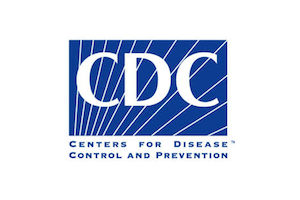
Despite the lack of official studies, the CDC recorded the reported negative effects of synthetic cannabinoid overdose between 2010 and 2015 and of 277 drug overdose patients who reported synthetic cannabinoid as the sole agent:
- 66.1% reported problems in the central nervous system (such as feeling agitation, falling into a coma, suffering from toxic psychosis),
- 17% reported that they suffered from cardiovascular problems (such as tachycardia, bradycardia, arrhythmia),
- 7.6% reported that they had pulmonary problems (such as having irritated lungs or coughing fits;
- 5.4% of that 7.6% reporting they suffered from respiratory depression, also known as hypoventilation, and which is where one has slow and ineffective breathing),
- 4% of those that suffered from negative effects from synthetic cannabinoid use reported that they had serious acute kidney injury.
What are Phytocannabinoids?
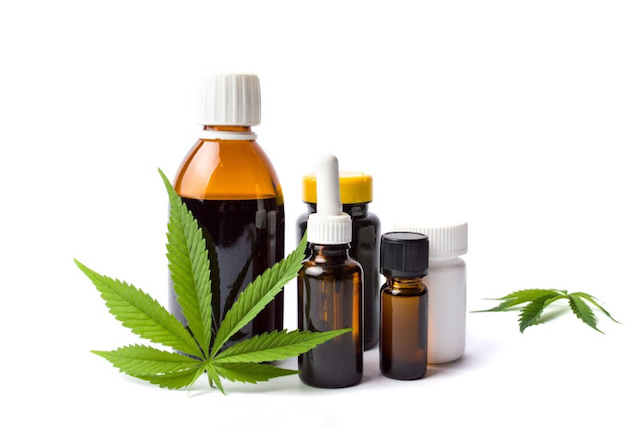
Unlike the cannabinoids that occur naturally in the bodies of most animals and the harmful and not fully regulated synthetic cannabinoids, phytocannabinoids are found naturally occurring in both the cannabis plant and are found in the hemp plant, each with varying levels of concentration depending on a variety of factors. The potency of the phytocannabinoids found in hemp, for example, can depend on the age of the plant. Cannabis’ phytocannabinoid levels, on the other hand, is something that is more commonly known to be affected by different internal and external sources, such as the specific strain of the plant in addition to the plant’s age.
Basically, phytocannabinoids are the chemical compounds that provide the beneficial effects provided by CBD use and are also the chemical compounds that are responsible for both the positive and negative effects that can come with marijuana use and they can have differing effects on the user due to variables such as the number of phytocannabinoids that are present, and how potent each of those phytocannabinoids are.
There are a variety of different phytocannabinoids that have been identified as being present in cannabis plants and hemp plants by the scientific and medical communities, and many more that are suspected to be present, and which are currently being investigated in various ongoing research projects. Currently, we know that there are at least 110 different phytocannabinoids that can be identified and isolated from cannabis and hemp. Out of these more than 110 identified phytocannabinoids, there are a handful that the medical community has a strong understanding of at present, with the rest of the known phytocannabinoids either being researched or are waiting to undergo research in the future.
In this guide, we are going to list each of these phytocannabinoids that are known to play an important role in the Endocannabinoid System, and we will provide each phytocannabinoid listing with a short description of what is currently known about them, and where it is known, we will provide a list of potential positive and negative effects from their use.
CBGA
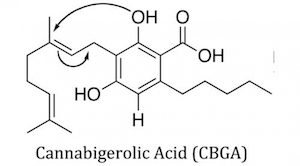
Cannabigerol Acid is one of many minor cannabinoids that are produced by the cannabis plant, and on its own is not known to have any remarkable effects on the Endocannabinoid System. CBGA is still very important, however, because it is the parent molecule from which a variety of other cannabinoids (which do have a noticeable effect on the Endocannabinoid System) are synthesized. CBGA is a foundational compound of the cannabis flower and is at the top of the cascade reaction that produces three major phytocannabinoid lines. These phytocannabinoid lines are:
- THCA Tetrahydrocannabinolic Acid)
- CBDA (Cannabidiolic Acid)
- CBCA (Cannabichromenic Acid)
These three chemical lines each eventually becomes one of the more commonly known phytocannabinoids: THC (Tetrahydrocannabinol), CBD (Cannabidiol), or CBC (Cannabichromene / Cannabichrome / Cannanbichromene / Pentylcannabichromene / Cannabinochromene), respectively. CBGA may also convert to CBG (Cannabigerol ) under specific circumstances, but in a majority of strains, CBGA will either eventually convert into THC or it will convert into CBD.
The scientific community has known about CBG ever since it was first reported, more than 50 years ago. It was a group of Israeli researchers that were the first to isolate this particular phytocannabinoid. It was 30 years later that Japanese researchers revealed that CBGA was its precursor, a link that had been suspected for a short amount of time before being proven. Despite the long history that CBGA has in the field of science and medicine, minimal research has been conducted on CBGA to date, so there is not much known about any potential treatments or cures that it could be utilized into providing.
Researchers have, however, demonstrated a consistent way of replicating the phytocannabinoid by using a specific species of yeast, which is known as Pichia pastoris. Pichia pastoris is widely used for recombinant DNA protein duplication for a variety of different scientific research and medical uses. Since the discovery of the duplication method using Pichia pastoris, researchers have performed a variety of computational modeling processes in order to optimize the duplication of CBGA.
It was in early 2019 that a California-based research team published their work on the complete synthesis of phytocannabinoids—including CBGA—from yeast-based derivatives. Despite the aforementioned minimal research that has been done to-date on CBGA and how it can be effectively utilized in the fields of science and health, it is likely that we will see an increase in the amount of research that is done of CBGA in the future, considering how crucial it is in the process of creating THC, CBD, and CBC.
CBG
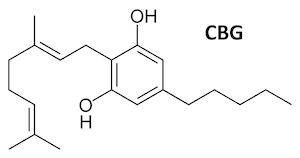
Cannabigerol is the non-acidic form of Cannabigerolic Acid. Cannabigerol is a very minor part of cannabis. During growth, most of the cannabigerol is converted into other, more well known, cannabinoids, primarily tetrahydrocannabinol (THC) or cannabidiol (CBD). In the end, this leaves only about 1% cannabigerol in the cannabis plant. It currently does not have any known beneficial or negative effects on its own in regards to the Endocannabinoid System and its functions. Because CBGA almost always converts to THC, CBD, or CBC, CBG itself is not a phytocannabinoid that many people will have any experience with—but due to CBG’s connection with one of the single most versatile and important acid compounds found in cannabis (CBGA, its prior acid-based form)—CBG is still considered to be of importance and holds a lot of scientific and medical interest to many researchers worldwide.
THCA
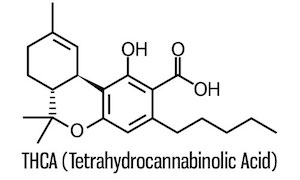
Tetrahydrocannabinolic Acid is a precursor chemical compound to the more commonly found THC. A precursor chemical compound is, simply put, a chemical compound that participates with one or more chemical compounds in one or more chemical reactions in which the chemical reaction’s process or conclusion results in the production of another distinct chemical compound. Because THCA is a precursor chemical compound to THC, it means it shares many of the same chemical properties that are present in THC, which results in these two distinct phytocannabinoids sharing many of the same potential positive and negative effects on those using a product that is either predominantly THCA-based or that is predominantly THC-based. THCA is often the majority constituent in most cannabis resin concentrates that are commonly used recreationally.
For example, THCA is the main active phytocannabinoid ingredient that is found in most instances of hashish (also commonly shortened to simply “hash”), hash-derived oils, many cannabis-derived waxes, and the increasingly more popular resin-based product that is commonly known as shatter. Shatter is a hard, translucent and amber-colored (either light amber or sometimes a darker amber color) concentrate that is similar in its texture and in its appearance to regular glass, and which derives its name from the physical attributes that are shared with panes of colored glass.
Possible effects from the use of THCA can include, but are not limited to:
- Feelings of euphoria, or an elated feeling;
- Feeling of lethargy or sleepiness;
- Dizziness, or lightheadedness;
- Dry, red eyes and / or itchy eyes;
- Dry mouth, commonly referred to as “cottonmouth”;
- Increased heart rate (tachycardia), heart palpitations, or noticeably uncomfortable heart rhythm;
- An increased appetite, which is commonly known as having “the munchies,” and;
- Generalized or acute feelings of paranoia
THC

Tetrahydrocannabinol, which is commonly known as THC, is the primary psychoactive constituent of the cannabis plant. THC is theorized to be a part of the cannabis plant’s natural self-defense system, putatively against predation by its natural predators (a variety of vegetative-eating insects), as a defense against ultraviolet light damage, and as a defense mechanism against a variety of other common environmental stressors, both biotic environmental stressors (such as fungi, virus, bacteria, and nematodes), and against other common abiotic environmental stressors(such as toxins, salinity levels, drought, temperatures higher than the plant’s natural upper-temperature survivability range, and temperatures that are lower than the plant’s natural lower temperature survivability range).
The most basic explanation of THC as a chemical compound is that it is the primary phytocannabinoid that gives users of cannabis and cannabis-derived products the “high” that virtually every user has reported feeling, at least in varying degrees of strength. The introduction of THC into one’s system will affect the user of cannabis or cannabis-derived product in slightly different ways, depending on a variety of internal and external factors:
- The overall potency of the product (how much THC it has per total weight),
- how much THC that is introduced into the user’s body over a specific period of time,
- the introduction method (if the cannabis or cannabis-derived product is smoked, vaped, digested, et cetera),
- the cannabis-based end-product that is used to introduce THC (sinsemilla loose-leaf, regular loose-leaf, hashish, or a resin product, such as hash oil, wax, or shatter),
- the user’s body weight,
- the user’s overall tolerance level,
- whether or not the user has recently eaten,
- or whether or not the user has taken another drug and/or medication in conjunction with the THC,
- or has not waited an ample amount of time between the last time they took another drug or medication before taking the THC.
How potent of a “high” that the THC provides, after taking these factors into account, will play a major role in how impaired the user is (the intensity of the high) and for how long the impairment lasts (the duration of the high).
The scientific and medical communities have known about THC since it was first isolated by Raphael Mechoulam and Yechiel Gaoni at the Weizmann Institute of Science in Israel, both of whom also introduced the elucidation (explanation) of THC’s overall chemical structure, and were also the first two to totally synthesize the phytocannabinoid. Despite the fact that THC as a chemical compound was unknown until the work of these two Isreali researchers, humans as a society have known about the effects that are caused by the presence of THC in cannabis for an incredibly long time.
The history of cannabis as a drug and its recreational, medical and / or religious usage by humans dates back to at least the third millennium B.C. in written history, and likely it dates further back based on various archaeological evidence has been found which suggests that humans have been using cannabis for an astounding percentage of our total history as a species.
Unfortunately, the use of cannabis also has a long history of being viewed as immoral or as a dangerous activity that should be outlawed and punished. The earliest restrictions being placed on cannabis use were reported in the Islamic world in the early part of the 14th century. In the 19th century, it began to be restricted in colonial countries (which is a country that has been taken over by another country, and had the conquering country’s laws, societal norms and often their religion imposed on the colonial country), and these newly placed impositions were often associated with racial and / or class stressors. In the middle of the 20th century, international governmental and organizational coordination led to swift, harsh, vast and sweeping restrictions being placed on cannabis use and cultivation throughout most of the globe.
Despite all of this, at its 33rd official meeting—which occurred in 2003—the World Health Organization (known as the WHO; the WHO is a specialized agency of the United Nations that is concerned with international public health at all levels) agency’s Expert Committee on Drug Dependence recommended transferring THC specifically to Schedule IV of the Convention. Schedule IV is the second-lowest level of class-scheduled drugs that the World Health Organization classifies drugs into. Schedule IV controlled drugs includes some weaker barbituates (such as phenobarbital) and other hypnotics, anxiolytic benzodiazepines (with the exception of flunitrazepam, which is commonly known as Rohypnol, due to its potential and history of abuse), and some weaker stimulants (for example modafinil and armodafinil), among other drugs that are considered “safe” and have low thresholds for abuse.
This proposed reclassification was made citing the various important medical uses of THC, and its low abuse potential for virtually all of the approximately 183 million regular users worldwide (according to the United Nations Office on Drugs and Crimes’ published 2017 report). Despite the strong medical and scientific evidence, there is that THC use should be more socially acceptable, many countries in the world still treat cannabis use as an immoral and dangerous activity. Thankfully, society’s views on the morality, safety, and medical relevance of THC use has been getting more and more positive over the years, and many world governments are changing their laws on THC use to better reflect this. As a matter of fact, according to a 2019 opinion poll conducted by the Pew Research Center, more than two-thirds of Americans that participated in the poll support the legalization of cannabis use.
According to the Pew Research Center, the amount of adults in the United States that oppose legalization has fallen from 52% in 2010 to 32% today that still oppose it having its legalization status being changed. According to the full survey results, an overwhelming majority of American adults (91% of them) believe that marijuana should be legal. This is further broken down into the 59% of Americans that believe it should be made legal for both medical and recreational use, while the other 32% participating adults believe it should be legal for medical use only. Fewer than one-in-ten (which is only 8% of American adults polled) prefer to keep marijuana use illegal in all circumstances, including for medical use in terminal cases and in other severe medical needs cases.
Possible effects from the use of THC can include, but are not limited to:
- Euphoria;
- Feeling of lethargy;
- Dizziness, or lightheadedness;
- Dry, red and / or itchy eyes;
- Dry mouth;
- Increased heart rate / heart palpitations;
- Increased appetite, and;
- Paranoia
CBDA
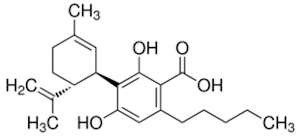
Cannabidiolic acid is a non-psychoactive phytocannabinoid and is the acidic precursor to the more commonly used CBD. CBDA can be found in the live and/or the raw form of cannabis, particularly in the hemp plant. CBDA can additionally be found in higher concentrations in strains that have been bred specifically to cultivate overall higher CBD levels. CBDA converts to CBD through decarboxylation, much like how most of the other acidic precursors behave in regards to their own chemical compound lines.
CBDA is often introduced into the body by way of consuming or juicing raw cannabis plant, specifically one that has not been overly aged. CBDA can also be found in some specific tinctures, topicals, and capsules that use raw, unheated cannabis or hemp plants. CBDA shows promise as an anticonvulsant, as an anti-nausea and vomiting agent, as an analgesic, and as an anti-inflammatory product. Essentially, CBDA has the same properties that the more commonly used and preferred CBD does, but it is viewed as being more natural and a “healthier” alternative to what is already an extremely healthy, safe, and all-natural phytocannabinoid. There is currently no scientific evidence that is backing the opinion that CBDA is better or more potent than CBD is, but there is also no scientific evidence that says it is worse for you or less potent than CBD is, so in the end, it’s really just a matter of preference.
Possible effects from the use of CBDA can include, but are not limited to:
- Joint / muscle / generalized pain relief;
- Reduced inflammation;
- Healthier appetite;
- Better and more restful sleep;
- Decrease in anxiety / anxious feelings;
- Decrease in depression / depressive feelings;
- Better overall mood;
- Improvements to skin health, and;
- Improvements to hair and nail health
There is also a small chance that CBDA use can cause one or more of the few undesirable side-effects that CBDA use has been reported as potentially causing. These are:
- Dry mouth;
- Drowsiness or fatigue, and;
- Nausea
CBD

Cannabidiol is the main phytocannabinoid that people are talking about when they bring up the numerous health benefits that regular use of hemp-based or cannabis-based products can provide. CBD is considered by many to be among one of the most important medical discoveries in modern history for its proven and suspected overall positive contributions to physical, emotional, and mental healthcare ever since it was first discovered in 1940 and since the initiation of clinical research in earnest in 2018 on cannabidiol as a chemical compound, including preliminary studies of its effect on anxiety, cognition, movement disorders, and pain.
CBD accounts for at least 40% of the hemp plant’s total extract. There is a vast amount of different CBD-based products that allow the users of this particular phytocannabinoid to choose the delivery method that best suits their tastes, needs, and goals for taking CBD. Some of the more common ways that people like to take their CBD is by inhalation of hemp oil-derived vapor (such as in vape pens or as vape juices), a fast-acting sublingual spray, by ingesting soft gel capsules, by making a tea or a coffee that has been blended with CBD, by using skincare or other healthcare products that have been made using CBD, or a huge number of other ways.
CBD is a very versatile phytocannabinoid overall. It is often taken in a form where CBD has been isolated, so it is the only active ingredient that is present in the product. Or it can be supplied in a product that includes terpenes, natural essential oils, and other phytocannabinoids, which can provide a variety of different benefits to the user, depending on what it has been designed to do. This is achieved because different blends of phytocannabinoids, different concentrations, and different healthy additives can cause the product to have an overall different desired effect.
CBD, because as a compound it is chemically different from THC, it does not have the same psychoactivity that THC does. Because of this CBD can provide its numerous benefits without causing any changes or a decrease in overall cognitive function, which is something that a lot of CBD users prefer, whether it’s due to the lifestyle that they live, or because of moral views on cannabis use, or the legality of THC and cannabis use in the region that they live, or whatever else might make them more hesitant to use THC. Speaking of the differences between CBD and THC, and the legality of THC and cannabis use: CBD-based products that have been derived from industrial hemp is completely legal to buy and use. In the United States, the cannabis-extracted cannabidiol-based drug Epidiolex was approved by the Food and Drug Administration in 2018 for the treatment of two epilepsy disorders.
Additionally, as of 2018, new Federal Legislation was signed into law in the United States, which removed hemp from its previous Schedule 1 status and has reclassified it as an “agricultural commodity.” Because of this federal legislation that was passed (it is known as the 2018 Farm Act), it has legalized the cultivation of industrial hemp in the United States, which has really boosted the CBD-based commodity market, causing it to explode in size recently. The legality of specific CBD products depends on one big factor: its derived source, which essentially means its THC content.
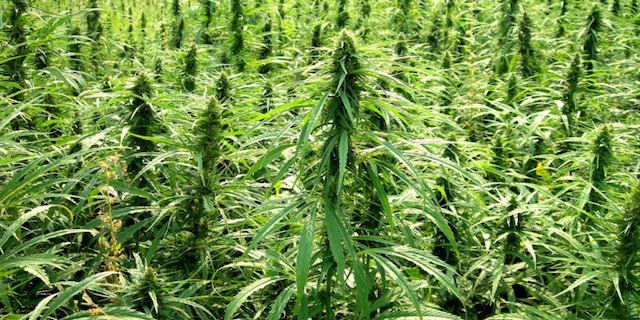
CBD is present in both industrial hemp plants and in cannabis plants, but the THC content of industrial hemp plants generally only contains 0.3% of THC by total weight, whereas cannabis plants contain a minimum of 30% THC by total weight, depending on the specific cannabis strain in question. So your CBD product will have to have 0.3% or less of detectable THC in total for it to be federally legal.
As of the writing of this guide, the mechanism of action for CBD’s biological effects have not been fully determined, meaning scientists and doctors know what CBD does to the Endocannabinoid System, but not exactly why it does it. There is ongoing research happening all the time in numerous different countries and through a variety of different organizations and labs into how else CBD can be used to benefit users as there is a firm science-backed belief that we don’t fully understand the extent of CBD’s benefits, which is really amazing when you consider what we currently do know about what CBD can do for humans.
Possible effects from the use of CBD can include, but are not limited to:
- Joint / muscle / generalized pain relief;
- Reduced inflammation;
- Healthier appetite;
- Better and more restful sleep;
- Decrease in anxiety / anxious feelings;
- Decrease in depression / depressive feelings;
- Better overall mood;
- Improvements to skin health, and;
- Improvements to hair and nail health
There is also a small chance that CBD use can cause one or more of the few undesirable side-effects that CBD use has been reported as potentially causing. These are:
- Dry mouth;
- Drowsiness or fatigue, and;
- Nausea
CBNA
Cannabidiolic Acid is found in abundance in live hemp plants, but it is converted to the better known phytocannabinoid Cannabinol (CBN) over time and when it has been exposed to heat. Essentially, when cannabis is exposed to the air for long enough (or it has been exposed to ultraviolet light long enough for it to manipulate the process), THCA (Tetrahydrocannabinolic Acid) will turn into CBNA. Because THCA is the precursor chemical to THC, this means that cannabis that has been properly aged for long enough or that has undergone the proper UV exposure, products that use cannabis that contains CBNA will not affect your Endocannabinoid System the same way that cannabis containing THC will.
CBNA will provide the benefits of CBD, but it will have a more potent effect than introducing normally processed cannabis will, as the counteracting effect that THC and CBD have on each other will not be present, allowing the small amount of CBD that is naturally found in cannabis to be able to work better. In addition to exhibiting the same beneficial properties that CBD has, CBNA also has a mild psychoactive property to it, so cannabis products that have been aged in order to have CBNA to be present will still cause similar experiences to normal THC use, to a certain degree.
In essence, CBNA provides many of the same benefits that CBD does, but it is usually introduced into the body alongside CBD itself, allowing for the two to work in tandem.
Possible effects from the use of CBNA can include, but are not limited to:
- Joint / muscle / generalized pain relief;
- Reduced inflammation;
- Healthier appetite;
- Better and more restful sleep;
- Decrease in anxiety / anxious feelings;
- Decrease in depression / depressive feelings;
- Better overall mood;
- Improvements to skin health,and;
- Improvements to hair and nail health;
Note: it is not believed that these benefits are capable of reaching the efficacy that using a more potent CBD product would be able to provide, considering the fact that CBNA itself is not nearly as potent as CBD.
CBN
Cannabinol (not to be confused with Cannabidiol / CBD) use is more common than CBNA use is, because smoking aged cannabis is still the more common introduction method, and the decarbing process that cannabis that is used for smoking generally undergoes has caused the CBNA to become CBN. CBN is a mildly psychoactive cannabinoid that is found only in very trace amounts in cannabis plants and plant parts, and even then, it is mostly only found in detectable levels in aged mature cannabis plant parts. Upon completion of the process outlined above in the CBNA section, CBN can be formed by decarboxylation (which is a chemical reaction that removes a carboxyl group and releases carbon dioxide, or CO2) of the CBNA. CBN is CBNA that has undergone the process of decarboxylation (often just called “decarbing”), which means CBN also comes from hemp or cannabis that has been aged longer than usual.
While using “old” hemp or cannabis products might be a turn-off for some, many others seek out older cannabis or aged hemp just so they can enjoy the particular effects or uses of CBN. Clinical research studies into uses for CBN have found that it may act as a very strong antibacterial agent. As detailed in a research paper that was published on the United State’s National Library of Medicine National Institutes of Health’s website in 2008, in laboratory settings, CBN was tested on strains of the Methicillin-Resistant Staphylococcus Aureus (MRSA) bacteria. These researchers found it to be a surprisingly potent antibacterial agent against these resistant strains, which is a very important find. MRSA is an infection-causing bacteria that has become resistant to traditional antibiotics and which poses a very serious threat to human life, particularly in regards to the very young and the very old. In fact, according to the Centers for Disease Control (CDC), there were more than 120,000 Staphylococcus aureus bloodstream infections and approximately 20,000 MRSA-associated deaths that occurred in the United States in 2017.
In addition to being an antibacterial agent, CBN has been linked by preliminary research on laboratory rodents as potentially being a way to fight against Amyotrophic Lateral Sclerosis (ALS). In another laboratory rodent study, it was found that CBNA has anti-inflammatory properties, similar to the properties exhibited by CBD in research that has been done on it. Finally, CBNA has been linked with having an impact on appetite stimulation.
Because CBN has anti-inflammatory properties similar to CBD, using a product that has both of these phytocannabinoids present will help to boost the benefits that you get from using the product either for a chronic illness or an acute inflammation caused by an injury or the like. CBNA might also be able to be used as an alternative for those that need an increase in their appetite for health reasons, as not everyone wants to or can use/take a product that is THC-rich. THC is a phytocannabinoid that has proven and well-documented effects on stimulating appetite, so it is nice that there is a potential all-natural alternative out there for those that might need it.
Possible effects from the use of CBN can include, but are not limited to:
- Euphoria;
- Joint / muscle / generalized pain relief;
- Reduced inflammation;
- Healthier appetite;
- Better and more restful sleep;
- Decrease in anxiety / anxious feelings;
- Decrease in depression / depressive feelings;
- Better overall mood;
- Improvements to skin health,and;
- Improvements to hair and nail health;
- Feeling of lethargy;
- Dizziness, or lightheadedness;
- Dry, red and / or itchy eyes;
- Dry mouth;
- Increased heart rate / heart palpitations;
- Increased appetite, and;
- Paranoia
Note: the following four phytocannabinoids are what are considered to be minor phytocannabinoids. These chemical compounds don’t have a large presence in either industrial hemp or in cannabis, and there has only been a little—if any—scientific or medical research into the benefits and / or the mechanism of action for each of these compounds. Despite this, there is still a belief that they play some part in the overall efficacy and potency of phytocannabinoid-rich products that include them.
Minor Phytocannabinoid: CBC
Cannabichromene—which is often also called cannabichrome, cannabichromene, pentylcannabichromene or cannanbinochromene depending on the source—is one of the cannabinoids found in the cannabis plant. Its biological and chemical structure bears many similarities to some other known natural cannabinoids, including tetrahydrocannabinol (THC), tetrahydrocannabivarin (THCV), cannabidiol (CBD), and cannabinol (CBN). Due to these similarities, it’s possible that CBC can provide users with many of the same benefits and detrimental effects that these other phytocannabinoids are often known for, just with less overall efficacy.
Possible effects from the use of CBC can include, but are not limited to:
- Euphoria;
- Feeling of lethargy;
- Dizziness, or lightheadedness;
- Dry, red and / or itchy eyes;
- Dry mouth;
- Increased heart rate / heart palpitations;
- Increased appetite, and;
- Paranoia
Minor Phytocannabinoid: CBL
Cannabicyclol is a non-psychoactive phytocannabinoid found in cannabis. CBL is a degradative product like cannabinol, but with Cannabichromene (CBC) degrading into CBL through natural irradiation or under various specific acid conditions. CBL currently has no known effects that are unique to it.
Possible effects from the use of CBL can include, but are not limited to:
- Euphoria;
- Feeling of lethargy;
- Dizziness, or lightheadedness;
- Dry, red and / or itchy eyes;
- Dry mouth;
- Increased heart rate / heart palpitations;
- Increased appetite, and;
- Paranoia
Note: it is not believed that these benefits are capable of reaching the efficacy that CBC use would provide, considering the fact that CBLis not nearly as potent as CBC.
Minor Phytocannabinoid: CBDV
Cannabidivarin—which is also known as cannabivarichromene—is a non-psychoactive phytocannabinoid that is found in cannabis plants. It is a homolog of cannabidiol (CBD). Being a homolog of CBD simply means it has the same relation, relative position, or structure. CBDV is a propyl cannabinoid, which means it has a three-carbon alkyl substituent with the chemical formula –CH2CH2CH3 for the linear form. CBDV is regarded as being a highly effective anticonvulsant and is used in certain treatments for treating brain cancer and/or for treating epilepsy. CBDV is probably best known for its aforementioned strong anticonvulsant effects but additionally provides many similar benefits as CBD, just in varying degrees of potency.
Minor Phytocannabinoid: THCV
Tetrahydrocannabivarin is a homolog of THC, but has a propyl (3-carbon, same as CBDV above) side chain instead of a pentyl (5-carbon, which is normal for many phytocannabinoids) group on the molecule; this change in THCV’s side chain makes THCV produce very different effects from what THC use does. Unlike THC, CBD, and CBC, THCV doesn’t begin as cannabigerol acid (CBGA). Once THCV is created, (wherein geranyl pyrophosphate joins with divarinolic acid, as opposed to being combined with olivetolic acid to create CBGA) the process continues exactly the same as it would for the creation of THC. CBGVA is broken down into tetrahydrocannabivarin carboxylic acid (THCVA) by the enzyme THCV synthase. At that point, THCVA can be decarboxylated with heat or UV light to create THCV. THCV is currently being researched for its use as a new potential treatment against obesity-associated glucose intolerance.
Importance of Phytocannabinoid-Rich and Phytocannabinoid-Diverse Products
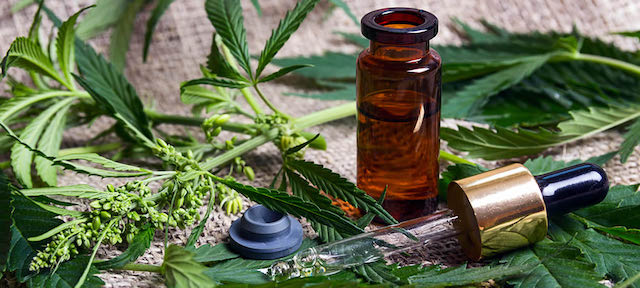
Taking a product that has many different phytocannabinoids present, and at potent levels, will ensure that you are taking a product that is among the best in terms of quality and is among the fastest-acting products commercially available. Having high levels of phytocannabinoids obviously increases the overall potency of the product in question, which means it will give you greater benefits than taking a product that has comparatively very little phytocannabinoid presence. However, taking phytocannabinoid-diverse products—that is to say, a product that has many different phytocannabinoids present—can be of benefit to you in a way that you might not have heard of or considered before. Products that are phytocannabinoid-diverse are strongly believed to provide what many refer to as “The Entourage Effect”.
Quick Reference Glossary
- Endocannabinoids: these are lipid-based retrograde neurotransmitters that grow in most living organisms and whose job it is to bind to cannabinoid receptors.
- Endocannabinoid System: this is a biological system that is comprised of Endocannabinoids and cannabinoid receptor proteins which are expressed throughout the vertebrate central nervous system (even including the brain) and throughout the peripheral nervous system.
- Cannabinoid Receptor: these are located throughout the body and are a major part of the Endocannabinoid System. Cannabinoid receptors are involved in a variety of physiological processes including appetite stimulation and suppression, pain-sensation, general mood, memory, and other biological processes.
- Cannabinoid: is any chemical compound that is a member of a group of closely related compounds, and which can be found either occurring naturally in animals and / or the cannabis plant or which can be synthetically manufactured. Cannabinoids have varying effects on the Endocannabinoid System, depending on the specific cannabinoid and its potency.
- Synthetic Cannabinoid: a synthetically manufactured chemical compound that is a member of the cannabinoid group of compounds. Synthetic Cannabinoid is commonly used to emulate the effects of cannabis use, without having to restricted by the same laws and regulations that cannabis does. Due to the process of manufacture and the goal that is trying to be achieved, these are designer drugs. Synthetic Cannabinoids have varying effects on the Endocannabinoid System, usually with the goal of behaving in a way that produces the feelings that THC does.
- Phytocannabinoid: a chemical compound that falls into the closely related group of compounds known as cannabinoids. Phytocannabinoids are cannabinoids that are found naturally occurring in the cannabis plant and the hemp plant. Phytocannabinoids have varying effects on the Endocannabinoid System.
- Endogeneity / Endogenous: these are biomolecules that are naturally occuring in an organism, tissue or cell system.
- Lipid: this is a biomolecule that is soluble in non-polar solvents.
- Non-Polar Solvents: are solvents featuring bonds between atoms with similar electronegativities, which means they lack partial charges. As an example, hydrocarbon oils are non-polar solvents.
- Retrograde Signaling: this is the process in biology where a signal travels backward from a target source to its original source.
- Ligand: involved in both biochemistry and pharmacology, this is a substance that forms a complex compound with a biomolecule in order to serve one or more biological purposes.
- Decarboxylation / Decarbing: this is a chemical reaction that removes a carboxyl group and releases carbon dioxide (CO2) as a result of the process. Usually, decarboxylation refers to a reaction of carboxylic acids, which results in the removal of a carbon atom from a carbon chain. Decarbing is how you prepare cannabis for consumption, particularly for edibles, because this is the process that converts cannabis’ non-intoxicating THCA into the more commonly used psychoactive phytocannabinoid THC.
- Homolog / Homologue / Homologous: a compound that has the same relation, relative position, or structure as another compound.
- Cannabis Strain: this is the specific strain of a cannabis plant. Cannabis strains are cultivated in order to achieve specific levels of potency, desired trace percentages of particular phytocannabinoids, and for intended uses. The two major strains of cannabis plants that are grown for specific uses are known as Indica and Sativa. Indica strains commonly provide users with a sense of deep relaxation, mind, and body. Sativa strains, on the other hand, tend to provide users a more energizing and engaging “high” experience.
Resources
- The CDC’s general info on Synthetic Cannabinoids can be found here.
- The CDC’s page for Synthetic Cannabinoid Intoxication can be found here.
- For use in case of Synthetic Cannabinoid ingestion or inhalation, the number to contact your local Poison Control Center for United States residents is 1-800-222-1222 and their website can be found here for more information.
- For use in case of Synthetic Cannabinoid ingestion or inhalation, the number to use for United Kingdom residents is the NHS 111 line, which can be reached by dialing 111 or via their website.
- The National Center for Biotechnology Information’s general research report on phytocannabinoids can be found here.
- Our CBD FAQ can be quickly be reached here.
